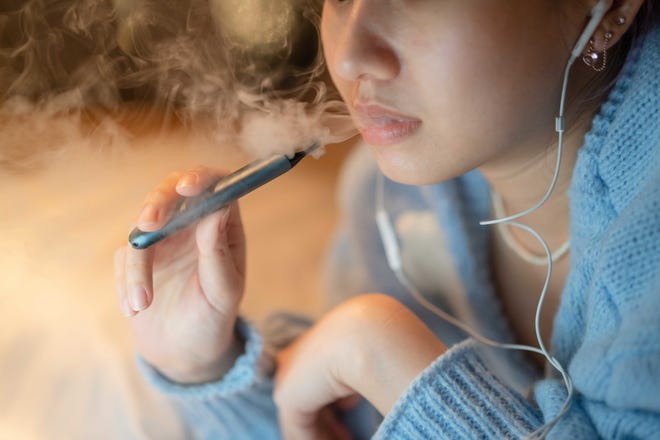Secondhand e-cigarette vapor may be harmful to children just like secondhand smoke: Study
Researchers found that children in the study who were regularly around vaping had higher levels of metabolites, or molecules, linked to chemicals found in e-cigarettes in their bodies
 Mary Walrath-Holdridge
Mary Walrath-Holdridge
We all know that secondhand cigarette smoke is a bad thing − the dangers of tobacco smoke exposure to children specifically have long been known to cause ailments from asthma attacks and infections to Sudden Infant Death Syndrome.
What we know less about, however, are the effects of prolonged exposure to electronic cigarette vapor. One set of researchers recently took to finding answers to that question.
A recent study presented this month at the conference of the National Association of Pediatric Nurse Practitioners found that secondhand "smoke," or vapor from vaping and e-cigarettes may, in fact, impact the children in your life, not unlike traditional cigarettes and tobacco.
How researchers studied the effects of secondhand e-cigarette exposure
The study, conducted by researchers at Emory University’s Nell Hodgson Woodruff School of Nursing and Rollins School of Public Health, evaluated the effects of secondhand electronic cigarette exposure through multiple means in children ages 4 through 12.
Traditionally, blood tests are considered the standard for evaluating secondhand smoke impacts, but the team also used less invasive saliva testing and exhaled breath tests to determine what the children of vaping adults were exposed to. They then compared this to a control group of kids who were not regularly exposed to e-cigarette vapor.
Researchers found that children in the study who were regularly around vaping had higher levels of metabolites, or molecules, linked to chemicals found in e-cigarettes in their bodies. These can disrupt dopamine levels in the body, cause inflammation, and lead to cellular damage due to oxidative stress. This cellular damage is linked to numerous diseases like diabetes, heart disease and cancer.

Menthol cigarette ban:Where does menthol cigarette ban stand? Inside the high-stakes battle at Biden's door.
Not a harmless cigarette alternative
With laws and regulations around traditional tobacco products becoming stricter, many manufacturers moved over to vapes and electronic cigarettes in the 2000s. They have largely been marketed towards a younger audience, leading to legislation that bans flavors considered attractive to kids, and to people who are trying to quit smoking or looking for a "less harmful" way to consume tobacco.
E-cigarettes as we know them now were widely introduced in the U.S. in 2007. By 2008, the World Health Organization (WHO) proclaimed that it did not consider electronic cigarettes a legitimate smoking cessation aid and demanded that manufacturers remove these claims from marketing materials. By 2011, the U.S. Food and Drug Administration (FDA) announced it would regulate e-cigarettes like traditional cigarettes and tobacco products under the Food Drug and Cosmetics Act.
However, the misconception of vapes and e-cigarettes being "better" or harmless compared to traditional cigarettes has stuck around.
“Many people who smoke have switched to using e-cigarettes, thinking it’s safer for them and others nearby,” Jeannie Rodriguez, associate professor at Emory’s School of Nursing and lead author of the study, said in a statement published by the college. “However, there are chemicals in the liquids used in a vape that are hazardous for you and those that you care about who are exposed to the vapors you exhale.”
Teens using THC:Teen delta-8 use rising, now equates to 1-2 students in average class size, study shows
Parents largely unaware that vaping causes secondhand smoke exposure
After the study, a focus group of parents was informed of the findings. Many seemed surprised to hear just how harmful vaping around their children could be, according to researchers.
Of the parents who were vape users, more than half (11 of 19) shared that they thought vaping around their kids was a "minor health hazard or not a health hazard at all." Additionally, 12 of 22 parents who used these products said they did not know if exposure to electronic cigarette vapors was harmful to children, according to the research presentation.
Multiple parents shared that they had turned to vaping as a tool to lessen or stop the use of cigarettes, and more expressed a belief that vaping was overall healthier and safer than traditional tobacco use.

“The appeal for vaping is that, at least in my mind and I say this all the time to people that ask me, I say, vaping for me is probably about 95% better than smoking cigarettes," said one parent quoted in the findings. “For me, it seems it portrays itself as the healthier version," said another.
Others said that they believed their bodies felt better while vaping, leading them to think it was better overall, while others said that the simple power of addiction was what kept them turning to e-cigarettes.
“If you do vape and are ready to quit, talk to your health care provider and your family and friends,” Rodriguez said in a statement. “You may need the support of those around you to be successful. Think of past attempts to quit not as failures, but as training opportunities for you to eventually successfully quit. Don’t give up.”